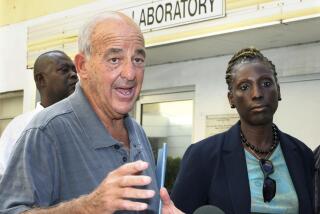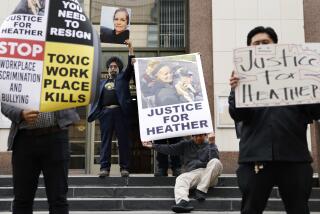Dr. Theodore Curphey Dies; 1st County Doctor-Coroner
- Share via
Dr. Theodore Curphey, the reform-minded pathologist who was the first physician selected as the then-new Los Angeles County chief medical examiner-coroner, is dead. Curphey, who ordered the controversial “psychological autopsy” of Marilyn Monroe after her 1962 suicide, was 89 when he died Thursday in a Pasadena nursing home.
He was the respected coroner of Nassau County, N.Y., from 1938 to 1957, when the Los Angeles County Board of Supervisors chose him to head the new medical examiner’s office here.
Before Curphey’s appointment the county office had existed under a public administrator and guardian, not a physician.
He set about to change procedures in the office he inherited and in the process stepped on some political toes.
Judicial Attacks
As The Times noted in a 1958 editorial, shortly after Curphey took over, he “has been called curt, rude, tactless . . . arrogant.” Those attitudes and a series of judicial attacks about autopsy reforms he effected put him at odds with county officialdom and a grand jury investigation was ordered.
But Curphey and his scientific, if controversial, approaches to the office were vindicated and he eventually headed a medical team that was hailed in the scientific community for its progressiveness.
The Times noted that he “has been guilty (only) of bad official relations.”
Curphey, who also was on the faculties of USC, UCLA and Loma Linda University, left the coroner’s office on Oct. 25, 1967, his 70th birthday--the mandatory retirement age--but continued to serve as a consultant in the field of forensic medicine and on the Suicide Prevention Bureau, which he founded.
He was succeeded by Dr. Thomas T. Noguchi, himself a controversial coroner who eventually was demoted by the supervisors.
Famed Monroe Case
Although Noguchi has received most of the publicity surrounding the disputed Monroe autopsy, which he conducted, it was Curphey who supervised the entire investigation.
On Aug. 17, 1962, Curphey held a news conference in which he stated, “It is my conclusion that the death of Marilyn Monroe was caused by a self-administered overdose of sedative drugs and that the mode of death is probable suicide.”
No formal inquest was ever held into the death, but it appeared from the start to be a suicide. Because of that, the main investigative agency handling the case was the Los Angeles County coroner’s office, not the police.
Rather than conduct a public inquest, where sworn testimony could be taken, Curphey decided to appoint a three-member team of mental health professionals to probe into Monroe’s background and find out what happened. The move was novel for its time, although some psychological autopsies had been conducted for a few years before Monroe’s death.
Key People Missing
The investigation lasted only 11 days, and years later critics pointed out that several key people who might have had knowledge of Monroe’s last days were not interviewed. The interviews that were taken were informal and not under oath. For example, Peter Lawford, who talked to Monroe on the phone only hours before her death, was not interviewed by investigators for the Los Angeles Police Department until 1975.
Curphey generally declined to comment on the case over the years, although the conduct of his office was repeatedly under attack from critics who suspected foul play in Monroe’s death. In 1982, the Los Angeles County district attorney’s office issued a detailed investigative report that generally supported the conclusions reached by Curphey.
Curphey’s wife, Aies, died previously. He is survived by a daughter, two sons, six grandchildren and four great-grandchildren.
His ashes will be scattered at sea.
More to Read
Sign up for Essential California
The most important California stories and recommendations in your inbox every morning.
You may occasionally receive promotional content from the Los Angeles Times.













